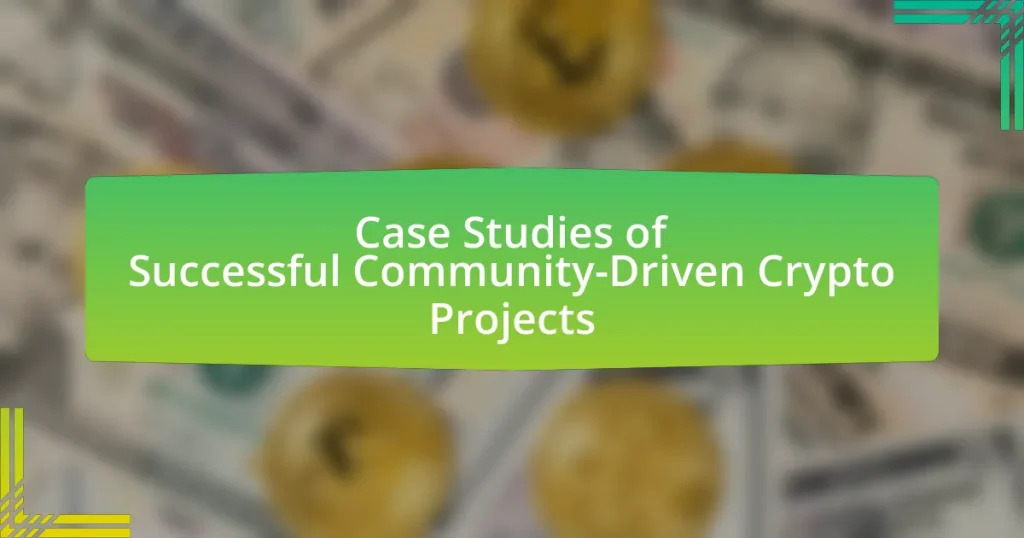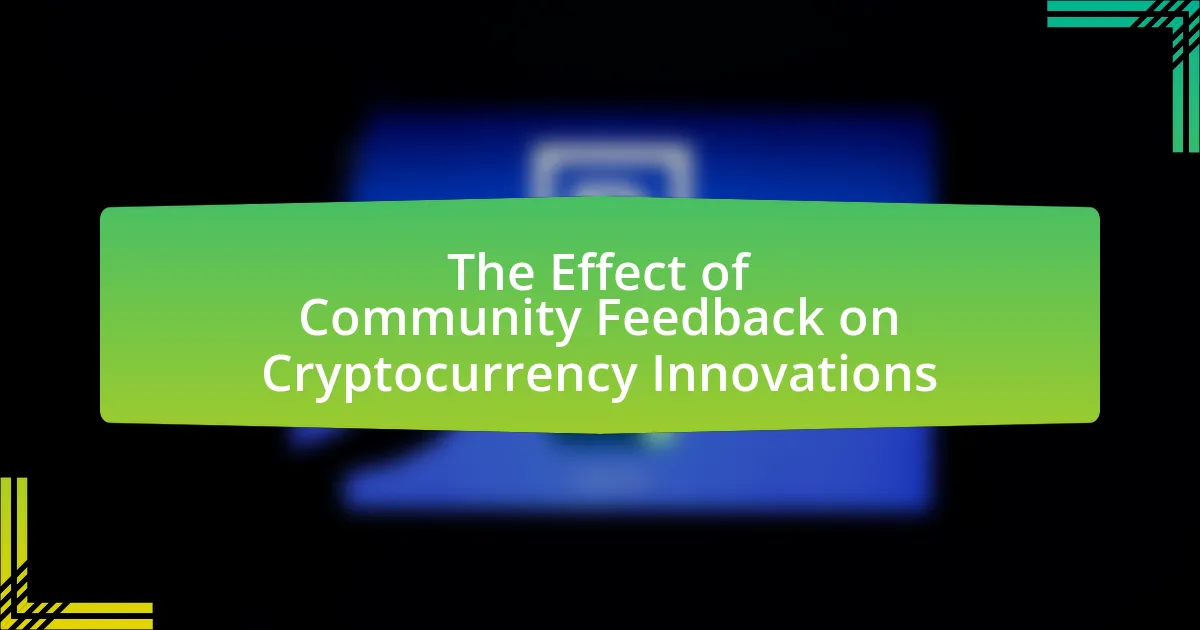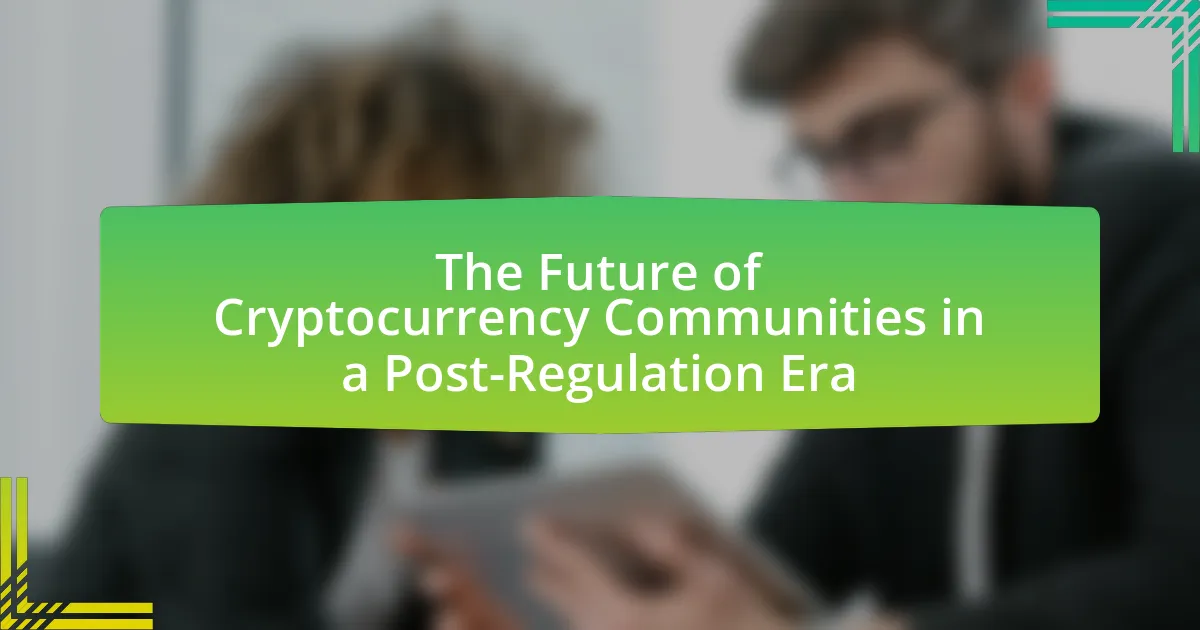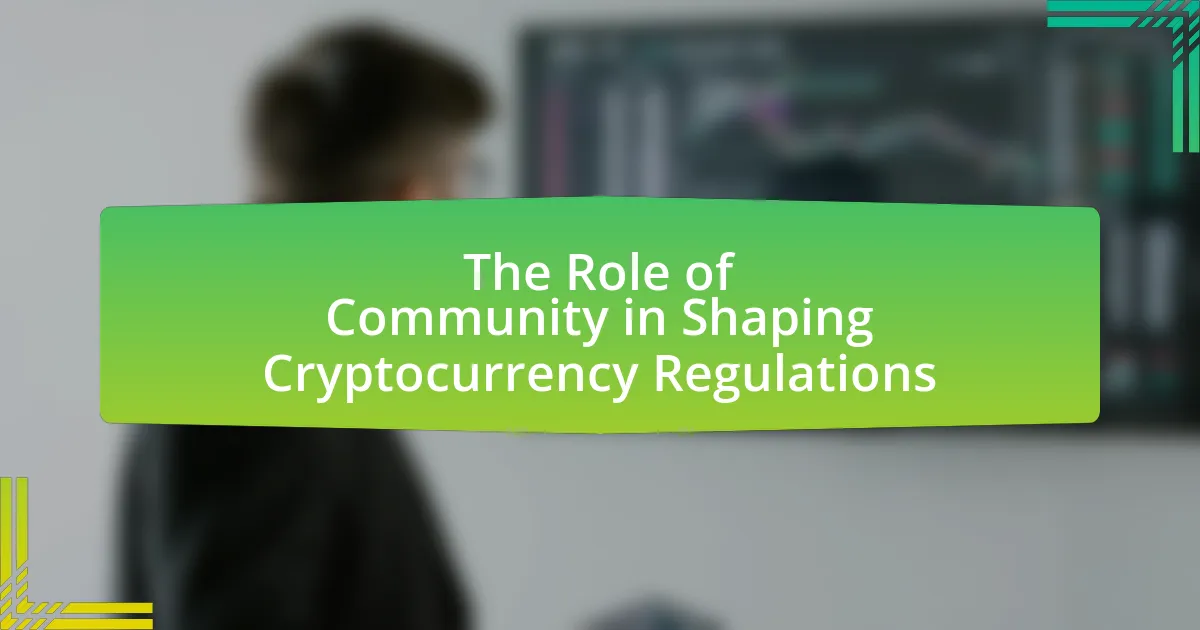Community-driven crypto projects are blockchain initiatives that emphasize user involvement and decentralized governance, allowing token holders to influence key decisions. This article explores the characteristics that distinguish these projects from traditional crypto models, highlighting the roles of community members in governance, development, and engagement. It examines notable case studies, such as Ethereum and Dogecoin, which demonstrate the impact of community participation on project success. Additionally, the article addresses challenges faced by these projects, including governance issues and funding sustainability, while outlining best practices for enhancing community engagement and trust.
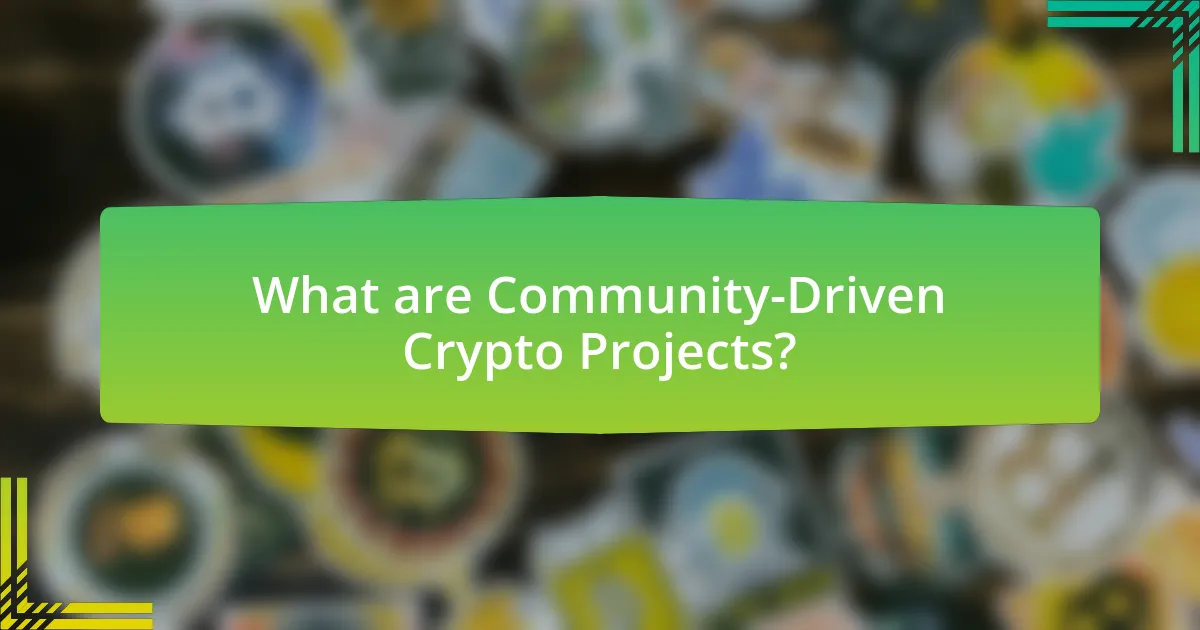
What are Community-Driven Crypto Projects?
Community-driven crypto projects are blockchain initiatives that prioritize the involvement and decision-making of their user communities over centralized control. These projects often utilize decentralized governance models, allowing token holders to vote on key issues, such as protocol upgrades and fund allocation. For example, projects like Ethereum and MakerDAO exemplify community-driven governance, where stakeholders actively participate in shaping the future of the platform. This model fosters transparency, inclusivity, and a sense of ownership among users, which can lead to increased engagement and innovation within the ecosystem.
How do community-driven crypto projects differ from traditional crypto projects?
Community-driven crypto projects prioritize active participation and governance from their user base, contrasting with traditional crypto projects that often rely on centralized decision-making by a core team. In community-driven projects, stakeholders typically have voting rights and influence over project direction, fostering a sense of ownership and collaboration. For instance, projects like Ethereum and Cardano have implemented decentralized governance models, allowing community members to propose and vote on changes, which enhances transparency and adaptability. In contrast, traditional projects may follow a top-down approach, where decisions are made by a small group of developers or executives, limiting user engagement and responsiveness to community needs.
What roles do community members play in these projects?
Community members play crucial roles in community-driven crypto projects by participating in governance, contributing to development, and fostering community engagement. In governance, members often vote on proposals and decisions, influencing the direction of the project. For development, they may contribute code, provide feedback, or assist in testing, which enhances the project’s functionality and security. Additionally, community members engage in marketing and outreach, helping to grow the user base and promote the project. These roles are essential for the sustainability and success of community-driven initiatives, as evidenced by projects like Ethereum, where community involvement has been pivotal in its evolution and adoption.
How is decision-making structured within community-driven projects?
Decision-making within community-driven projects is typically structured through a decentralized governance model that emphasizes collective input and consensus. In this model, stakeholders, including community members and project contributors, participate in discussions and voting processes to influence project direction and decisions. For instance, many successful community-driven crypto projects, such as Ethereum and MakerDAO, utilize mechanisms like proposals and community votes to ensure that decisions reflect the collective will of the participants. This approach fosters transparency and accountability, as decisions are made openly and are subject to community scrutiny, thereby enhancing trust and engagement among members.
Why are community-driven crypto projects gaining popularity?
Community-driven crypto projects are gaining popularity due to their emphasis on decentralization and user engagement. These projects empower participants to have a direct influence on decision-making processes, fostering a sense of ownership and loyalty among users. For instance, platforms like Ethereum and Cardano have thrived by involving their communities in governance and development, leading to increased trust and collaboration. Additionally, a report by the Blockchain Research Institute highlights that community-driven initiatives often result in higher levels of innovation and adaptability, as they can quickly respond to user needs and market changes. This combination of engagement, trust, and adaptability is driving the rise of community-driven crypto projects.
What factors contribute to the success of these projects?
The success of community-driven crypto projects is primarily influenced by strong community engagement. Active participation from community members fosters collaboration, innovation, and a sense of ownership, which are critical for project sustainability. For instance, projects like Ethereum and Cardano have thrived due to their vibrant communities that contribute to development, governance, and marketing efforts. Additionally, transparent communication and effective leadership within these communities enhance trust and alignment towards common goals, further driving project success.
How do community-driven projects foster user engagement and loyalty?
Community-driven projects foster user engagement and loyalty by creating a sense of belonging and active participation among users. These projects often involve users in decision-making processes, allowing them to contribute ideas and feedback, which enhances their emotional investment. For instance, platforms like Ethereum have established community governance models where users can vote on proposals, leading to increased commitment and loyalty. Research indicates that projects with strong community involvement see higher retention rates; for example, a study by the Blockchain Research Institute found that community-driven initiatives can boost user engagement by up to 50%. This active participation not only strengthens user relationships but also cultivates a loyal user base that feels valued and heard.
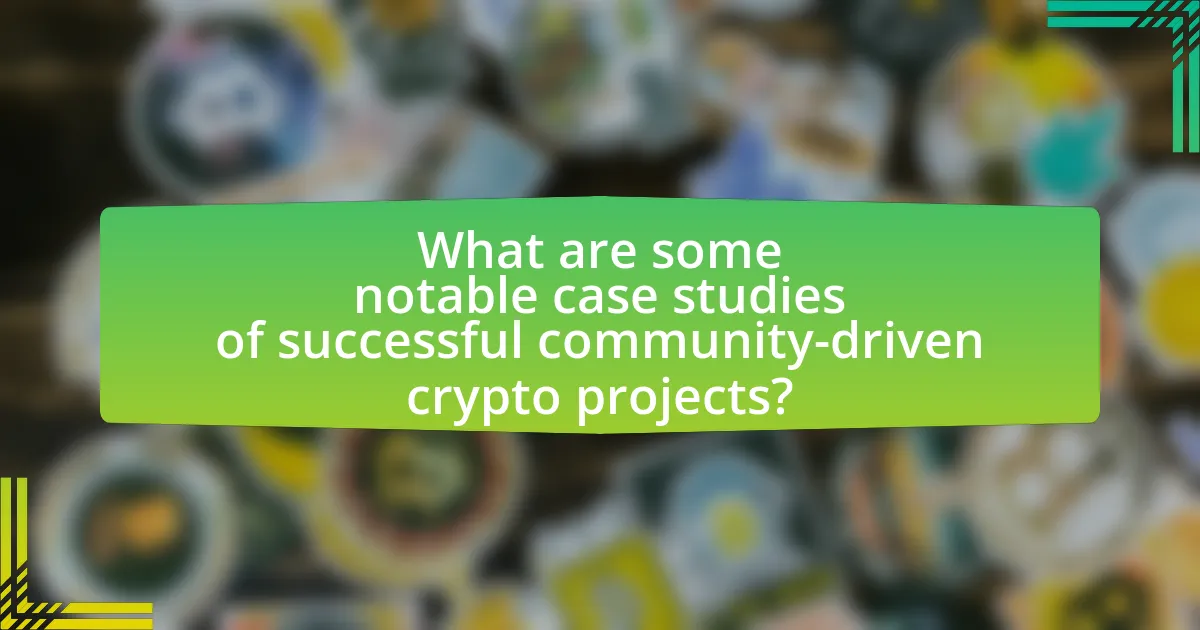
What are some notable case studies of successful community-driven crypto projects?
Notable case studies of successful community-driven crypto projects include Ethereum, which was developed through community collaboration and has become a leading platform for decentralized applications, and Dogecoin, which started as a meme but gained a strong community that propelled its popularity and market value. Ethereum’s community-driven approach facilitated the implementation of smart contracts and decentralized finance (DeFi), leading to a market capitalization exceeding $200 billion as of 2023. Dogecoin’s community engagement, particularly through social media and charitable initiatives, helped it achieve a market cap of over $10 billion, demonstrating the power of community in driving adoption and value in the crypto space.
How did the community contribute to the success of Bitcoin?
The community significantly contributed to the success of Bitcoin by fostering a collaborative environment that encouraged development, adoption, and advocacy. This collective effort led to the creation of essential infrastructure, such as wallets and exchanges, which facilitated user access and transaction processing. Additionally, community-driven initiatives, like the Bitcoin Improvement Proposals (BIPs), allowed users and developers to propose and implement enhancements, ensuring the protocol’s evolution. The active participation of the community in forums, social media, and events helped raise awareness and educate the public about Bitcoin, driving its adoption. Furthermore, the decentralized nature of the community ensured resilience against censorship and centralized control, which has been crucial for Bitcoin’s longevity and trustworthiness.
What specific community initiatives helped Bitcoin grow?
Specific community initiatives that helped Bitcoin grow include the establishment of forums like Bitcointalk, which facilitated discussions and knowledge sharing among early adopters, and the organization of meetups and conferences that fostered networking and collaboration. Additionally, the development of open-source software by community contributors allowed for continuous improvement and innovation within the Bitcoin ecosystem. These initiatives collectively created a supportive environment that encouraged user engagement and adoption, leading to Bitcoin’s growth as a decentralized currency.
How did community governance impact Bitcoin’s development?
Community governance significantly influenced Bitcoin’s development by enabling decentralized decision-making and fostering collaboration among users. This governance model allowed stakeholders to propose and debate changes to the protocol, exemplified by the Bitcoin Improvement Proposals (BIPs), which facilitated community input on upgrades and modifications. The consensus-driven approach ensured that changes reflected the collective interests of the network, as seen in the adoption of Segregated Witness (SegWit) in 2017, which was a result of extensive community discussion and agreement. This collaborative framework not only enhanced Bitcoin’s scalability and functionality but also reinforced its resilience against centralization, thereby maintaining its foundational ethos of decentralization.
What lessons can be learned from the success of Ethereum’s community?
The success of Ethereum’s community demonstrates the importance of collaboration and open governance in driving innovation. Ethereum’s community has effectively utilized decentralized decision-making processes, allowing diverse stakeholders to contribute to the platform’s development. This collaborative approach has led to significant advancements, such as the transition to Ethereum 2.0, which aims to improve scalability and sustainability. Furthermore, the community’s commitment to transparency and inclusivity has fostered trust and engagement among developers and users alike, exemplified by the numerous proposals and discussions held on platforms like GitHub and Ethereum Improvement Proposals (EIPs). These factors collectively highlight that a strong, engaged community can significantly enhance the resilience and adaptability of a blockchain project.
How did community feedback shape Ethereum’s upgrades?
Community feedback significantly shaped Ethereum’s upgrades by influencing the development priorities and implementation of features. The Ethereum community actively participates in discussions through forums, social media, and improvement proposals, such as Ethereum Improvement Proposals (EIPs), which allow developers and users to suggest changes. For instance, the transition to Ethereum 2.0, which introduced proof-of-stake, was heavily influenced by community concerns regarding scalability and energy efficiency. Feedback from users highlighted the need for a more sustainable and efficient network, leading to the adoption of these upgrades. This collaborative approach ensures that the upgrades align with the community’s needs and expectations, demonstrating the importance of user input in the evolution of the Ethereum platform.
What role did community events play in Ethereum’s adoption?
Community events significantly accelerated Ethereum’s adoption by fostering engagement, education, and collaboration among developers and users. These events, such as meetups, hackathons, and conferences, created platforms for knowledge sharing and networking, which were crucial in building a robust developer ecosystem. For instance, the Ethereum Devcon conferences have attracted thousands of participants, showcasing innovations and facilitating discussions that drive the technology forward. Additionally, community-driven initiatives like local meetups have helped demystify blockchain technology, making it more accessible to a broader audience. This grassroots involvement has been instrumental in cultivating a passionate community that actively contributes to Ethereum’s growth and development.
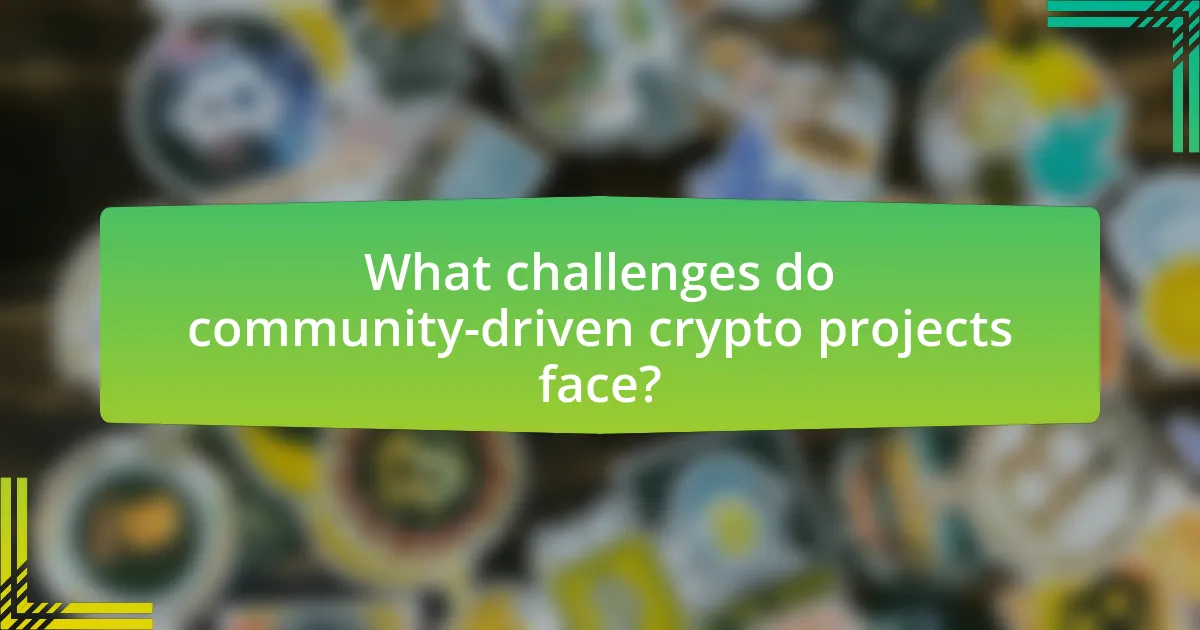
What challenges do community-driven crypto projects face?
Community-driven crypto projects face several significant challenges, including governance issues, funding sustainability, and community engagement. Governance issues arise when decision-making processes become contentious, leading to conflicts among community members, which can hinder project progress. Funding sustainability is a critical challenge, as many community-driven projects rely on donations or volunteer contributions, making it difficult to maintain long-term financial viability. Additionally, maintaining active community engagement is essential; without consistent participation and enthusiasm from members, projects may struggle to innovate or adapt to changing market conditions. These challenges can ultimately impact the project’s success and longevity in the competitive crypto landscape.
How can community-driven projects overcome governance issues?
Community-driven projects can overcome governance issues by implementing decentralized decision-making processes that empower all stakeholders. This approach fosters transparency and inclusivity, allowing diverse voices to contribute to governance. For instance, projects like Ethereum utilize decentralized autonomous organizations (DAOs) to facilitate collective decision-making, ensuring that governance is not concentrated in the hands of a few. Research indicates that DAOs can enhance participation and trust among community members, as seen in the successful governance of projects like MakerDAO, where token holders vote on key proposals, thereby reinforcing accountability and shared ownership.
What strategies can be implemented to ensure fair decision-making?
To ensure fair decision-making in community-driven crypto projects, implementing transparent governance structures is essential. These structures can include decentralized voting mechanisms that allow all stakeholders to participate in decision-making processes, thereby reducing the influence of any single entity. For instance, projects like DAOstack utilize a decentralized autonomous organization model that empowers community members to propose and vote on initiatives, ensuring that decisions reflect the collective will. Additionally, establishing clear guidelines and criteria for decision-making can help maintain consistency and fairness, as seen in the governance frameworks of successful projects like MakerDAO, which outlines specific processes for proposals and voting.
How can communities manage conflicts and disagreements effectively?
Communities can manage conflicts and disagreements effectively by implementing structured communication channels and conflict resolution frameworks. Establishing clear guidelines for dialogue, such as regular meetings and designated mediators, allows members to express their concerns in a constructive manner. Research indicates that communities utilizing collaborative problem-solving techniques, such as interest-based negotiation, achieve higher satisfaction rates in conflict resolution (Fisher, Ury, & Patton, “Getting to Yes”). Additionally, fostering a culture of transparency and inclusivity encourages members to voice their opinions, reducing misunderstandings and promoting collective decision-making.
What are the risks associated with community-driven crypto projects?
Community-driven crypto projects face several risks, including lack of regulatory oversight, potential for fraud, and volatility in market value. The decentralized nature of these projects often leads to insufficient governance structures, making them susceptible to scams and mismanagement. For instance, the DAO hack in 2016 resulted in a loss of $60 million due to vulnerabilities in smart contracts, highlighting the risks associated with community-driven initiatives. Additionally, the reliance on community consensus can lead to decision-making paralysis or conflicts, further jeopardizing project stability.
How can projects mitigate the risk of community fragmentation?
Projects can mitigate the risk of community fragmentation by fostering inclusive communication channels and actively engaging diverse community members. Establishing regular forums, such as town hall meetings or online discussions, allows for open dialogue and feedback, ensuring that all voices are heard. Research indicates that projects with strong community engagement strategies, like those employed by successful crypto initiatives, experience higher retention rates and lower fragmentation. For instance, the Ethereum community utilizes platforms like Discord and Reddit to facilitate discussions, which has contributed to its cohesive community structure.
What measures can be taken to protect against scams and fraud?
To protect against scams and fraud, individuals should implement a combination of awareness, verification, and security measures. Awareness involves educating oneself about common scams, such as phishing and Ponzi schemes, which can help in recognizing red flags. Verification includes checking the legitimacy of projects and individuals by researching their backgrounds, reading reviews, and confirming their presence on reputable platforms. Security measures involve using strong, unique passwords, enabling two-factor authentication, and keeping software updated to protect against vulnerabilities. According to the Federal Trade Commission, consumers reported losing over $3.3 billion to fraud in 2020, highlighting the importance of these protective measures.
What best practices can enhance the success of community-driven crypto projects?
To enhance the success of community-driven crypto projects, fostering active community engagement is essential. Engaging the community through regular communication, feedback loops, and transparent decision-making processes builds trust and loyalty among participants. For instance, projects like Ethereum have thrived by involving their community in governance discussions and development decisions, which has led to a robust ecosystem and continuous innovation. Additionally, providing educational resources and support can empower community members, enabling them to contribute effectively. Research indicates that projects with strong community involvement see higher levels of participation and investment, as evidenced by the success of platforms like Cardano, which emphasizes community-driven development and governance.
How can effective communication strengthen community ties?
Effective communication strengthens community ties by fostering trust, collaboration, and shared understanding among members. When community members engage in open dialogue, they are more likely to share ideas, resolve conflicts, and work towards common goals. Research indicates that communities with strong communication networks experience higher levels of participation and satisfaction, as evidenced by a study published in the Journal of Community Psychology, which found that effective communication practices led to increased community engagement and cohesion. This demonstrates that clear and consistent communication is essential for building and maintaining strong community relationships.
What role does transparency play in building trust within the community?
Transparency is crucial in building trust within the community as it fosters open communication and accountability. When community members have access to information regarding decision-making processes, financial transactions, and project developments, they are more likely to feel secure and valued. For instance, a study by the Harvard Business Review found that organizations that practice transparency experience higher levels of employee engagement and trust, which can be extrapolated to community dynamics. This openness reduces uncertainty and speculation, allowing members to engage more fully and collaboratively, ultimately strengthening the community’s cohesion and resilience.
